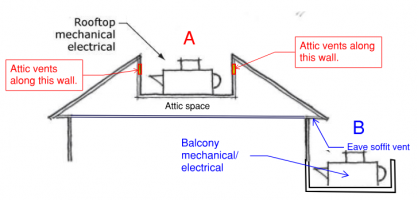-
Welcome to The Building Code Forum
Your premier resource for building code knowledge.
This forum remains free to the public thanks to the generous support of our Sawhorse Members and Corporate Sponsors. Their contributions help keep this community thriving and accessible.
Want enhanced access to expert discussions and exclusive features? Learn more about the benefits here.
Ready to upgrade? Log in and upgrade now.
You are using an out of date browser. It may not display this or other websites correctly.
You should upgrade or use an alternative browser.
You should upgrade or use an alternative browser.
Attic vents at rooftop mechanical well
- Thread starter Redmund
- Start date
steveray
SAWHORSE
Can't see why...FSD not an issue.....
mtlogcabin
SAWHORSE
I would say yes, install fire dampers and rate the wall based on Table 601.

[BG] SECONDARY MEMBERS. The following structural members shall be considered secondary members and not part of the primary structural frame:
1. Structural members not having direct connections to the columns.
2. Members of the floor construction and roof construction not having direct connections to the columns.
3. Bracing members other than those that are part of the primary structural frame.

[BG] SECONDARY MEMBERS. The following structural members shall be considered secondary members and not part of the primary structural frame:
1. Structural members not having direct connections to the columns.
2. Members of the floor construction and roof construction not having direct connections to the columns.
3. Bracing members other than those that are part of the primary structural frame.
steveray
SAWHORSE
But the rating in T601 is for the structure, not the openings.....Not to say that the framing for the opening at the opening might not need to be protected, but protected as structure, not as a penetrations...I would say yes, install fire dampers and rate the wall based on Table 601.
View attachment 10891
[BG] SECONDARY MEMBERS. The following structural members shall be considered secondary members and not part of the primary structural frame:
1. Structural members not having direct connections to the columns.
2. Members of the floor construction and roof construction not having direct connections to the columns.
3. Bracing members other than those that are part of the primary structural frame.
mtlogcabin
SAWHORSE
How do you protect the roof structure if you do not protect the opening?
This is one of those things we will not find a specific code section to point to. However, the intent of 601 is to protect the structural members, both primary and secondary so I believe opening protection should be addressed.
[A] 104.1 General.
The building official is hereby authorized and directed to enforce the provisions of this code. The building official shall have the authority to render interpretations of this code and to adopt policies and procedures in order to clarify the application of its provisions. Such interpretations, policies and procedures shall be in compliance with the intent and purpose of this code. Such policies and procedures shall not have the effect of waiving requirements specifically provided for in this code.
This is one of those things we will not find a specific code section to point to. However, the intent of 601 is to protect the structural members, both primary and secondary so I believe opening protection should be addressed.
[A] 104.1 General.
The building official is hereby authorized and directed to enforce the provisions of this code. The building official shall have the authority to render interpretations of this code and to adopt policies and procedures in order to clarify the application of its provisions. Such interpretations, policies and procedures shall be in compliance with the intent and purpose of this code. Such policies and procedures shall not have the effect of waiving requirements specifically provided for in this code.
steveray
SAWHORSE
Spray fireproofingHow do you protect the roof structure if you do not protect the opening?
mtlogcabin
SAWHORSE
Over the entire primary and secondary members?
I think a rated wall with opening protection would be less expensive.
If this is in an International Wildland-Urban Interface Code area, then soffit and gable ventilation protection maybe required anyway.

 www.vulcanvents.com
www.vulcanvents.com
I think a rated wall with opening protection would be less expensive.
If this is in an International Wildland-Urban Interface Code area, then soffit and gable ventilation protection maybe required anyway.

Metal Gable Vents | Louvered Fire Safe Vents - Vulcan Vents
Vulcan Vents makes fire-resistant Metal Gable vents. Our Louvered stainless steel vents are installed on the exterior walls entry point of home for embers.
klarenbeek
REGISTERED
Is the wall itself required to be constructed as a rated wall? If it is, the dampers are needed. If it's not, the fire damper will do little to protect the attic. The fire damper will fall down when the wall around it burns.
steveray
SAWHORSE
You protect it in the same manner you are already protecting the rest of the structure...Spray, drywall, whatever....Protected construction protects the structure....it does not slow the spread of fire.....Think Parking garage...generally fire protected and one big opening...Over the entire primary and secondary members?
I think a rated wall with opening protection would be less expensive.
If this is in an International Wildland-Urban Interface Code area, then soffit and gable ventilation protection maybe required anyway.

Metal Gable Vents | Louvered Fire Safe Vents - Vulcan Vents
Vulcan Vents makes fire-resistant Metal Gable vents. Our Louvered stainless steel vents are installed on the exterior walls entry point of home for embers.www.vulcanvents.com
Yikes
SAWHORSE
If the vents were legal as is they remain legal with or without the HVAC.
steveray
SAWHORSE
I don't like the fact that B might shoot the exhaust from the RTU into the attic, but not outright prohibited without more infoQuestion: do you see a fundamental difference in attic vent opening protection requirements in (A) vs. (B) below?
If so, what?
View attachment 10901
Yikes
SAWHORSE
In my opinion, in post #10, if you think "B" is code compliant, then "A" should also be considered code compliant.
There’s HVAC installation instructions that should keep the unit far enough away from the attic vents. Where is the code that prevents warm air that’s discharged from the unit from finding the attic vents?

